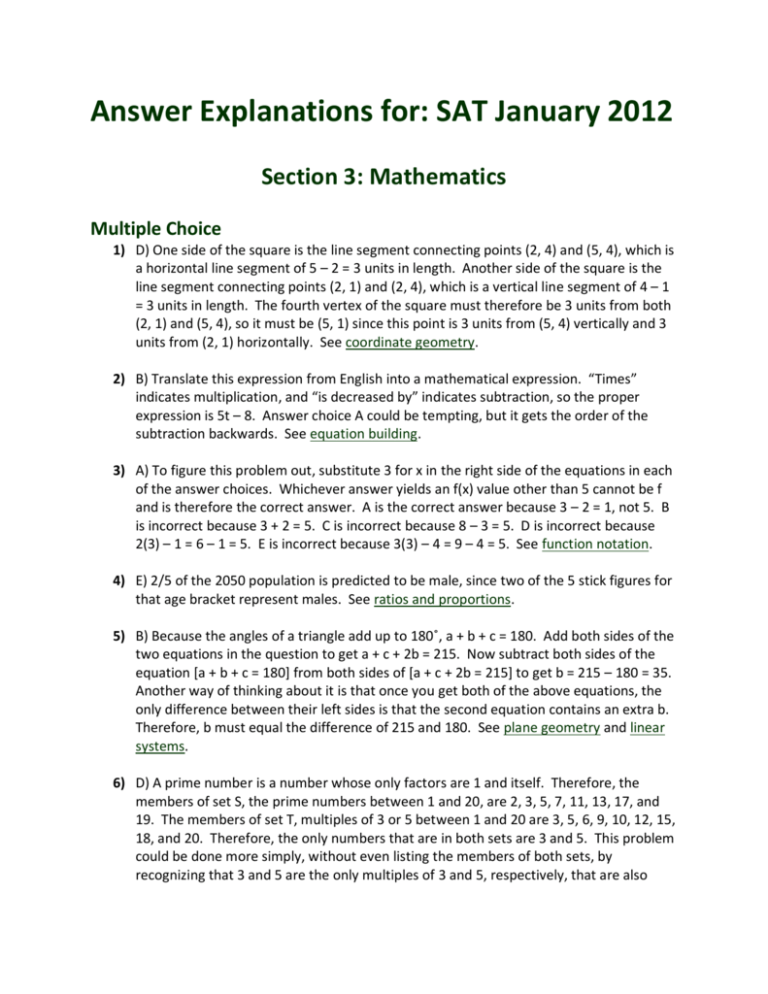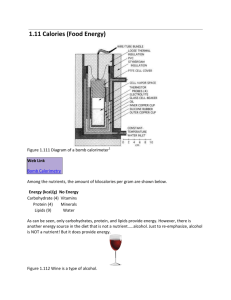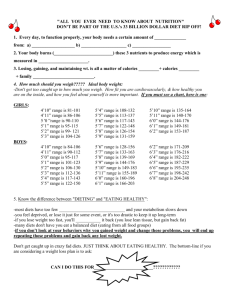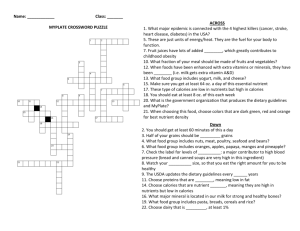Answer Explanations for: SAT January 2012 Section 3
advertisement

Answer Explanations for: SAT January 2012 Section 3: Mathematics Multiple Choice 1) D) One side of the square is the line segment connecting points (2, 4) and (5, 4), which is a horizontal line segment of 5 – 2 = 3 units in length. Another side of the square is the line segment connecting points (2, 1) and (2, 4), which is a vertical line segment of 4 – 1 = 3 units in length. The fourth vertex of the square must therefore be 3 units from both (2, 1) and (5, 4), so it must be (5, 1) since this point is 3 units from (5, 4) vertically and 3 units from (2, 1) horizontally. See coordinate geometry. 2) B) Translate this expression from English into a mathematical expression. “Times” indicates multiplication, and “is decreased by” indicates subtraction, so the proper expression is 5t – 8. Answer choice A could be tempting, but it gets the order of the subtraction backwards. See equation building. 3) A) To figure this problem out, substitute 3 for x in the right side of the equations in each of the answer choices. Whichever answer yields an f(x) value other than 5 cannot be f and is therefore the correct answer. A is the correct answer because 3 – 2 = 1, not 5. B is incorrect because 3 + 2 = 5. C is incorrect because 8 – 3 = 5. D is incorrect because 2(3) – 1 = 6 – 1 = 5. E is incorrect because 3(3) – 4 = 9 – 4 = 5. See function notation. 4) E) 2/5 of the 2050 population is predicted to be male, since two of the 5 stick figures for that age bracket represent males. See ratios and proportions. 5) B) Because the angles of a triangle add up to 180˚, a + b + c = 180. Add both sides of the two equations in the question to get a + c + 2b = 215. Now subtract both sides of the equation [a + b + c = 180] from both sides of [a + c + 2b = 215] to get b = 215 – 180 = 35. Another way of thinking about it is that once you get both of the above equations, the only difference between their left sides is that the second equation contains an extra b. Therefore, b must equal the difference of 215 and 180. See plane geometry and linear systems. 6) D) A prime number is a number whose only factors are 1 and itself. Therefore, the members of set S, the prime numbers between 1 and 20, are 2, 3, 5, 7, 11, 13, 17, and 19. The members of set T, multiples of 3 or 5 between 1 and 20 are 3, 5, 6, 9, 10, 12, 15, 18, and 20. Therefore, the only numbers that are in both sets are 3 and 5. This problem could be done more simply, without even listing the members of both sets, by recognizing that 3 and 5 are the only multiples of 3 and 5, respectively, that are also prime numbers, since any other multiple of either number would have a factor other than 1 and itself. See number properties. 7) A) Add 2ab to both sides of the equation to get a2 + b2 = 3ab. 8) C) If “A must be between C and D,” you can think of CAD as a three block unit. Considering the first rule alone, there are three possible placements for this unit: boxes 1-3, boxes 2-4, and boxes 3-5. In each of these three placements, the three block unit can be arranged CAD or DAC, allowing for 2 • 3 = 6 possibilities for this three block unit. However, CAD does not work in boxes 1-3 because the problem specifies that C cannot be in the first box. Similarly, DAC cannot be in in boxes 3-5 because the problem specifies that C cannot be in the fifth box. Finally, neither CAD nor DAC can be in boxes 2-4 since such a placement would prevent B from being next to E, as is specified by the problem. Therefore, there are only 2 placements left for blocks C, A, and D: CAD in blocks 3-5, and DAC in blocks 1-3. In either of these two placements, blocks B and E can be arranged BE or EB in the remaining two blocks for a total of 2 • 2 = 4 possible placements. To summarize, the following orders are possible: BECAD, EBCAD, DACEB, and DECBE. See counting and probability. Student Produced Response 9) 81) To figure out the number of campers, set up a proportion. To make sure you set it up right, make sure the units line up on both sides. In other words, this/that = this/that. Here, you have (counselors)/(campers) = (counselors)/(campers), so 2/9 = 18/x. To solve, cross multiply to get 2x = 9 • 18 2x = 162 x = 81. See ratios and proportions. 10) 7/4 or 1.75) The initial equation indicates that x = 1. If it is not immediately obvious that x = 1, you can divide both sides by 3/4 to determine that x = 1. Substitute 1 for x in the second equation to get 3/4 + 1 = 3/4 + 4/4 = 7/4. You could also grid in the decimal equivalent, 1.75. Be careful, because although this value can also be written as 1¾, there is no way to grid in mixed numbers, since 13/4 would be interpreted as thirteen fourths. 11) 1700) The table indicates that fat contains 9 calories per gram, so multiply 9 by 100 to get the total number of calories in 100 grams of fat. 9 calories/gram • 100 grams = 900 calories. If it was not intuitive to perform this multiplication, you could have set up a proportion. To make sure you set it up right, make sure the units line up on both sides. In other words, this/that = this/that. Here, you have (calories)/(gram) = (calories)/(gram), so 9/1 = x/100, so x = 100 • 9/1 = 900 calories. The table indicates that protein contains 4 calories per gram, so multiply 4 by 200 to get the total number of calories in 200 grams of protein. 4 calories/gram • 200 grams = 800 calories. Again, you could use proportions to figure out what math to do, as demonstrated above. Add the total calories from the 100 grams of fat to the total calories from the 200 grams of protein to get the answer to the question: 900 calories + 800 calories = 1700 calories. See ratios and proportions. 12) 44) To solve this problem, you do not need to find the length of each missing side, and in fact, there is no way to do so. You simply need to recognize that the sum of the two missing vertical sides must be equal to the known vertical side, 10, and the sum of the two missing horizontal sides must be equal to the known horizontal side, 12. Therefore, the perimeter of the figure is equal to 10 + 12 + 10 + 12 = 44. One way of visualizing why this method works is that you could essentially “pop out” the “dent” in the rectangle, resulting in a 12 by 10 rectangle. See plane geometry. 13) 31 x 41) Set up an inequality using the language of the first sentence. “Difference” indicates subtraction and “no more than” indicates less than or equal to. However, to find the full range of possible values of w, you must use an absolute value, since the problem indicates that it is unimportant which value (w or (3/2)x) is slightly larger than | 5. This inequality translates to the following two the other so | – inequalities: w – (3/2)x 5 and w – (3/2)x -5. Substitute 24 into each inequality for x and solve for w. Working with the first inequality, you get w – (3/2)24 5 w – 36 5 w 41. Working with the second inequality, you get w – (3/2)24 -5 w – 36 -5 w 31. Put these two inequalities together to get 31 x 41, which indicates that the dog could be any weight between 31 and 41 pounds, inclusive of 31 and 41. Although the above method is a good way to find all the possible weights of a qualifying dog of 24 inches length, it is not the most efficient way to solve this problem, since you only need to find one length that works. Because w and (3/2)x must be within 5 of each other, why not just make them equal to each other? If w = (3/2)x and x = 24, then w = (3/2)24 = 36. (You could also simply add 5 and subtract 5 to 36 to find the upper and lower limits of the dog’s weight without using absolute values or inequalities, but once you know that 36 is an acceptable answer, you are best off just answering the question and moving on.) See inequalities and the number line and absolute values. 14) 130) The sum of the interior angles of the pentagon in the figure is 3 • 180 = 540˚, since it is composed of three triangles. (The sum of the interior angles of a pentagon is always 540˚, since the formula for the sum of the interior angles of an n-sided figure is (n – 2)180, and (5 – 2)180 = 3 • 180 = 540.) The interior angles of the pentagon consist of three right angles, r, s, t, and ABC. Therefore, 3(90) + 140 + r + s + t = 540 410 + r + s + t = 540 r + s + t = 540 – 410 = 130. As is the case on many SAT problems where you are asked to solve for the value of a multi-variable expression rather than for a single variable, there is no way to solve for r, s, or t individually; you can only solve for their sum. See plane geometry. 15) 150) Subtract both sides of the bottom equation from both sides of the top equation to get (x + y + z) – (x – y – z) = 500 – 200 2y + 2z = 300 2(y + z) = 300 y + z = 300/2 = 150. Another way to solve this problem is to figure that the only difference between the top equation and the bottom equation is that the top equation adds (y + z) to x and the bottom equation subtracts (y + z) from x. Therefore, x must be halfway between 500 and 200, so x is 350, and (y + z) must be equal to the difference between 350 and either 500 or 200: 150. See linear systems. 16) 10) To solve, find points A and B and calculate the distance between these two points. Because point A is the point at which the graph intersects the x-axis (the x-intercept), the y-coordinate of point A must be 0. Therefore, you can plug in 0 for y and solve for x. 0 = 8 – (4/3)x (4/3)x = 8 x = 8(3/4) = 6. Since x = 6 when y = 0, the coordinates of Point A are (6, 0). Point B is y-intercept of the graph since it is the point at which the graph intersects the y-axis. If you are familiar with y-intercept form (y = mx + b, where m is the slope and b is the y-intercept), a quick glance at the equation reveals that the yintercept of the graph is 8. If this was not intuitive, you could have also plugged in 0 for x and solved for y (which would also give you y = 8), since the x-coordinate is always 0 at the y-intercept. Either way, the coordinates of point B are (0, 8). (Another way you could have found the values of A and B is by graphing the equation on your graphing calculator.) Now find the distance between points (6, 0) and (0, 8). Either use the distance formula or remember that the distance formula is simply the Pythagorean Theorem: one leg of the triangle is equal to the difference of the x values, the other leg is equal to the difference of the y-values, and the distance between the two points is equal to the hypotenuse. Therefore, (6 – 0)2 + (8 – 0)2 = d2 62 + 82 = d2 36 + 64 = d2 100 = d2 d = 10. Alternatively, you could have avoided using the Pythagorean Theorem/distance formula altogether once you found that the difference in the xcoordinates and the y-coordinates were 6 and 8 respectively. 6 and 8 are the legs of a 3-4-5 Pythagorean triple, since 6 = 3 • 2 and 8 = 4 • 2. Therefore, the hypotenuse (the distance between points A and B) is equal to 5 • 2 = 10. See coordinate geometry and right triangles. 17) 8/3, 2.66, or 2.67) Because the tank will be resting on one of its smallest faces (least area), it will be resting on a 2 ft by 3 ft face. Because the volume of a rectangular solid is equal to length time width times height, you can set up the following formula to solve for the height of the water: 16 = 2 • 3 • h 16 = 6h h = 16/6 = 8/3. 18) 8) If all four points are integers, the distance between every point must be an integer. Because the distance from c to d is the smallest distance between any of the four points, label this distance 1. Based on the information in the problem, the distance between b and c would therefore be 2 and the distance between a and b would therefore be 4. Because all four points are positive integers and you are trying to minimize the value of d, make point a the smallest positive integer, 1. (Point a must be the least of the four points since it is the furthest left on the number line.) If a = 1, then b = 1 + 4 = 5, c = 5 + 2 = 7, and d = 7 + 1 = 8. See inequalities and the number line.






